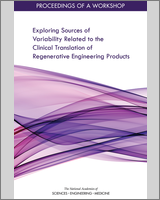NCBI Bookshelf. A service of the National Library of Medicine, National Institutes of Health.
The emerging multidisciplinary field of regenerative engineering is devoted to the repair, regeneration, and replacement of damaged tissues or organs in the body. To accomplish this it uses a combination of principles and technologies from disciplines such as advanced materials science, developmental and stem cell biology, immunology, physics, and clinical translation. The term "regenerative engineering" reflects a new understanding of the use of tissue engineering for regeneration and also the growing number of research and product development efforts that incorporate elements from a variety of fields. Because regenerative engineered therapies rely on live cells and scaffolds, there are inherent challenges in quality control arising from variability in source and final products. Furthermore, each patient recipient, tissue donor, and product application is unique, meaning that the field faces complexities in the development of safe and effective new products and therapies which are not faced by developers of more conventional therapies. Understanding the many sources of variability can help reduce this variability and ensure consistent results. The Forum on Regenerative Medicine hosted a public workshop on October 18, 2018, in Washington, DC, to explore the various factors that must be taken into account in order to develop successful regenerative engineering products. Invited speakers and participants discussed factors and sources of variability in the development and clinical application of regenerative engineering products, characteristics of high-quality products, and how different clinical needs, models, and contexts can inform the development of a product to improve patient outcomes. This publication summarizes the presentation and discussion of the workshop.
Contents
- The National Academies of SCIENCES • ENGINEERING • MEDICINE
- PLANNING COMMITTEE ON EXPLORING SOURCES OF VARIABILITY RELATED TO THE CLINICAL TRANSLATION OF REGENERATIVE ENGINEERING PRODUCTS
- FORUM ON REGENERATIVE MEDICINE
- Reviewers
- Acknowledgments
- Acronyms and Abbreviations
- 1. Introduction and Overview
- 2. Sources of Variability Associated with Regenerative Therapies: Lessons from Case Studies
- 3. Factors Contributing to Patient Variability
- 4. Addressing Variability in Donor Tissues and Cells
- 5. Addressing Variability and Meeting Quality Expectations in the Manufacturing Setting
- 6. Exploring Variability and Its Impact on Product Regulation and Outcomes
- 7. Potential Next Steps to Consider for Addressing Variability
- References
- Appendix A. Workshop Agenda
- Appendix B. Speaker Biographical Sketches
- Appendix C. Statement of Task
- Appendix D. Registered Attendees
Suggested citation:
Suggested citation: National Academies of Sciences, Engineering, and Medicine. 2019. Exploring sources of variability related to the clinical translation of regenerative engineering products: Proceedings of a workshop. Washington, DC: The National Academies Press. doi: https://doi.org/10.17226/25371.
Digital Object Identifier: https://doi.org/10.17226/25371
Additional copies of this publication are available from the National Academies Press, 500 Fifth Street, NW, Keck 360, Washington, DC 20001; (800) 624-6242 or (202) 334-3313; http://www.nap.edu.
Printed in the United States of America
- NLM CatalogRelated NLM Catalog Entries
- Review Applying Systems Thinking to Regenerative Medicine: Proceedings of a Workshop[ 2021]Review Applying Systems Thinking to Regenerative Medicine: Proceedings of a WorkshopNational Academies of Sciences, Engineering, and Medicine; Health and Medicine Division; Board on Health Sciences Policy; Forum on Regenerative Medicine, Beachy SH, Nicholson A, Teferra L, Hackmann M, Addie S. 2021 Mar 26
- Review Exploring the State of the Science in the Field of Regenerative Medicine: Challenges of and Opportunities for Cellular Therapies: Proceedings of a Workshop[ 2017]Review Exploring the State of the Science in the Field of Regenerative Medicine: Challenges of and Opportunities for Cellular Therapies: Proceedings of a WorkshopNational Academies of Sciences, Engineering, and Medicine, Health and Medicine Division, Board on Health Sciences Policy, Forum on Regenerative Medicine. 2017 Mar 15
- Proceedings of the Second Workshop on Theory meets Industry (Erwin-Schrödinger-Institute (ESI), Vienna, Austria, 12-14 June 2007).[J Phys Condens Matter. 2008]Proceedings of the Second Workshop on Theory meets Industry (Erwin-Schrödinger-Institute (ESI), Vienna, Austria, 12-14 June 2007).Hafner J. J Phys Condens Matter. 2008 Feb 13; 20(6):060301. Epub 2008 Jan 24.
- Review Regenerative medicine primer.[Mayo Clin Proc. 2013]Review Regenerative medicine primer.Terzic A, Nelson TJ. Mayo Clin Proc. 2013 Jul; 88(7):766-75.
- [Perspectives on regenerative therapy].[Nihon Geka Gakkai Zasshi. 2001][Perspectives on regenerative therapy].Inoue K. Nihon Geka Gakkai Zasshi. 2001 Mar; 102(3):282-7.
- Exploring Sources of Variability Related to the Clinical Translation of Regenera...Exploring Sources of Variability Related to the Clinical Translation of Regenerative Engineering Products
Your browsing activity is empty.
Activity recording is turned off.
See more...
